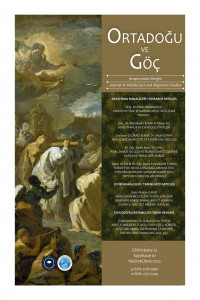YAHUDİLERİN GÖÇ TECRÜBESİNDE KUDÜS'ÜN KONUMU
THE PLACE OF JERUSALEM IN THE MIGRATION EXPERIENCE OF THE JEWS
Judaism, Jerusalem, Immigration, Aliyah, Messiah,
___
- Arslantaş, N. (2011) İslami Dönemde (638-1099) Filistin’e Yahudi Göçü ('Aliya: עלייה). Belleten, LXXV, (274), 641-689.
- Bir Yükseliş Hikâyesi "Aliya". Şalom Gazetesi. http://arsiv.salom.com.tr/news/print/6299-Bir-yukselis-hikayesi-Aliya.aspx adresinden 01 Nisan 2021 tarihinde erişildi.
- Bleich, J. D. (1979). Judea And Samaria: Settlement And Return. Tradition: A Journal of Orthodox Jewish Thought, 20, (3), 44-78.
- Broshi, M. (1979). The Population of Western Palestine in the Roman-Byzantine Period. Bulletin of the American Schools of Oriental Research, 236, 1-10.
- Cohon, S. S. (1925). Palestine in Jewish Theology. Hebrew Union College. 171-209.
- Fayda, M. (1989). Hz. Ömer Zamanında Gayr-ı Müslimler. İstanbul: Marmara İlahiyat Fakültesi Yayınları.
- Feyerabend, K. (ty.). A Complete Hebrew-English Pocket-Dictionary to the Old Testament. New York: The International News Company.
- Gil, M. (1992). A History of Palestine 634-1099. Cambridge: Cambridge University Press.
- Ginzberg, L. (1909). Geonica. Volume I. New York: The Jewish Theological Seminary of America.
- Glass, J. B. (2018). From New Zion To Old Zion: American Jewish Immigration and Settlement in Palestine, 1917-1939. Michigan: Wayne State University Press.
- Güç, A. (2003). Çeşitli Dinlerde ve İslâm’da Kurban, İstanbul: Düşünce Yayınevi.
- Hagopian, E. ve Zahlan, A. B. (1974). Palestine’s Arab Population: The Demography of The Palestinians. Journal of Palestine Studies, 3, (4), 32-73.
- Halamish, A. (2018). Immigration is Israel’s History. So Far. Israel Studies, 23, (3), 106-113.
- Hasanoğlu, E. (2015). Tanah’a Göre Kudüs’ün Kutsallaşma Süreci. Uludağ Üniversitesi İlahiyat Fakültesi Dergisi, 24, 125.148.
- Hassan, S. (2017). Jewish Migration from Arab Lands 1947-1949. Indian History Congress, 78, 886-892.
- Hayland, R. G. (1997). Seeing Islam as Other Saw it. Princeton: The Darwin Press.
- İsrail Dış İşleri Bakanlığı (1950). Law of Return 5710-1950. https://mfa.gov.il/mfa/mfa-archive/1950-1959/pages/law%20of%20return%205710-1950.aspx adresinden 3 Mart 2021 tarihinde erişildi.
- Jewish Case: The Place of Palestine in the Solution of the Jewish Questions. (ty.). New York: American Palestine Committee and Christian Council on Palestine.
- Louvish, M. ve Skolnik, F. (2007). “Aliyah”. Encyclopaedia Judaica. F. Skolnik (Ed.). Thomson Gale: Macmillan.
- Meral, Y. (2011) İbn Meymun’a Göre Yahudilik’te İman Esasları. Ankara Üniversitesi İlahiyat Fakültesi Dergisi, 52, (2), 243-266.
- Midrash Rabbah. Genesis. (1961). (H. Freedman trans.), London: The Sancino Press.
- Oppenheimer, F. (1914). Merchavia: A Jewish Co-Operative Settlement in Palestine. New York: The Jewish National Fund Bureau For America.
- Pittsburgh Platformu (1885). Declaration of Principles. Madde 5. www.ccarnet.org/rabbinic-voice/platforms/article-declaration-principles/ adresinden 5 Mart 2021 tarihinde erişildi.
- Ramban (Nachmanides). (1270). Hasagot HaRamban on Sefer HaMitzvot, Positive Commandments Omitted by Rambam, Mitzvah 4: 1. https://www.sefaria.org/Hasagot_HaRamban_on_Sefer_HaMitzvot%2C_Positive_Commandments_Omitted_by_Rambam.4.1?lang=en&with=Deuteronomy&lang2=en adresinden 3 Mart 2021 tarihinde erişildi.
- Raphael, M. L. (1973). Rabbi Jacop Voorsanger of San Francisco on Jews and Judaism: The Implications of the Pittsburgh Platform. American Jewish Historical Quarterly, 63, (2), 185-203.
- Schechter, S. (2007). A Dream of Zion: American Jews Reflect on Why Israel Matters to Them. J. K. Salkin (Ed.) Woodstock: Jewish Lights Publishing.
- Scholch, A. (1992). Britain in Palestine, 1838-1882: The Roots of the Balfour Policy. Journal of Palestine Studies, 22, (1), 39-56.
- Schwartz, J. (1981). Babylonian Commoners in Amoraic Palestine. Journal of the American Oriental Society, 101, (3), 317-322.
- Sidur K. Y. (2006). Liliane Zerbib Kazes. İstanbul: Gözlem Yayınları.
- Siegel, S. N. (2018). A new Exodus? Explaining Jewish Migration from Europe after the Cold War. Journal of Modern Jewish Studies, 17, (4), 416-433.
- The Apocalypse of Abraham. (1919). (G. H. Box, Trans.). New York: Macmillan Company.
- The Babylonian Talmud. (1935). (I. Epstein, Ed.), London: The Soncino Press.
- The Jewish Virtual Library. Aliyah in Judaism. https://www.jewishvirtuallibrary.org/aliyah adresinden 2 Şubat 2021 tarihinde erişildi.
- The Jewish Virtual Library. Israel Studies An Anthology. https://www.jewishvirtuallibrary.org/israel-studies-an-anthology-immigration-in-israel adresinden 31 Mayıs 2021 tarihinde erişildi.
- The Mishnah. (1933). (H. Danby, trans.). New York: Oxford University Press.
- Zakutinsky A. (2016). Is Aliyah a Mitzvah? https://www.ou.org/blog/is-aliyah-a-mitzvah/ adresinden 3 Mart 2021 tarihinde erişildi.
- ISSN: 2718-0980
- Yayın Aralığı: Yılda 2 Sayı
- Başlangıç: 2011
- Yayıncı: Kilis 7 Aralık Üniversitesi
YAHUDİLERİN GÖÇ TECRÜBESİNDE KUDÜS'ÜN KONUMU
AYINTAB’DA BİR CAMİ KİLİSE: SURP ASDVADZADZİN KİLİSESİ (KURTULUŞ CAMİ)
Fatih Yaman, GÖÇ VE TOPLUM, İstanbul: Ketebe Yayınları, 2019, 184 s.
ABD VE RUSYA’NIN SURİYE İÇ SAVAŞINA MÜDAHALELERİNİN JEOPOLİTİK YAKLAŞIMLARI
ROGER GARAUDY’NİN SİYASİ SİYONİZM HAKKINDAKİ GÖRÜŞ VE DÜŞÜNCELERİ
